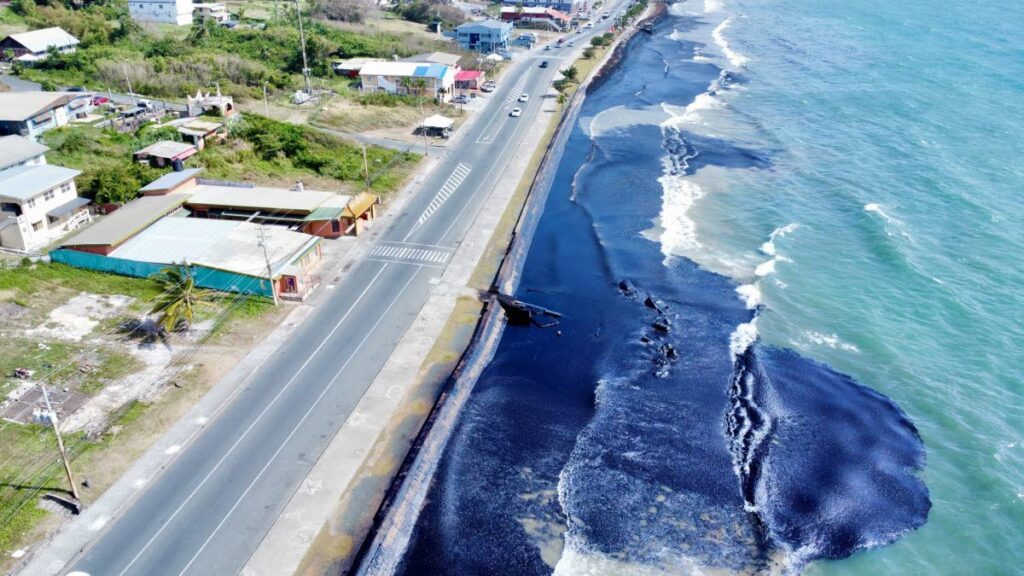[UPDATED] TEMA head: Oil resurfacing not unexpected, clean-up ongoing

ALMOST a year after the disastrous oil spill off the coast of Cove onFebruary 7, 2024, caused by the overturned Gulfstream barge, hydrocarbon deposits are still being found in Tobago's waters.
The oil spill affected approximately 15 km of Tobago southwestern coast and reached as far as Grenada and Bonaire.
In a media release on February 2, the Office of the Chief Secretary said oil had resurfaced along Petit Trou Bay, Lambeau.
It added that absorbent booms have been deployed along environmentally sensitive locations, particularly near wetlands.
The OCS said preliminary assessments by the Tobago Emergency Management Agency (TEMA) attributed the return of the oil to "a combination of natural factors."
Chief Secretary Farley Augustine held an emergency technical meeting on February 1 to assess the situation, review mitigation efforts and co-ordinate a plan.
Also present at the meeting were TEMA, the Environmental Management Authority, the Division of Health, Wellness and Social Protection and other stakeholders.
In an interview with Newsday on February 3, TEMA director Allan Stewart said the incident was not unexpected.
"What we have experienced is not something far-fetched. We were warned by Petrobas (a Brazilian oil company), who would have had a similar experience in 2019, to expect, in a two-year period, oil showing up as a result of sunken oil.
"That is the phenomenon currently at the Petit Trou Beach,where it has been confirmed that the oil present there was that of resurfacing oil that was buried below the sand.
"When I say buried, it was through natural movement of wave conditions. You would recognise we have been experiencing rough seas that affect the floor of the sea, and when you move closer to the shoreline, where you have erosion taking place...it would unearth some of the sunken oil."
Stewart said the agency has taken steps to protect the wetlands.
"It's happened between two rivers; the Thompson bridge and Bailey bridge, we have cordoned off that area in terms of utilising sorbent booms (long barriers made of absorbent material) to trap any hydrocarbon that through high-tide action may drive it up to the mangrove."
He said Cepep, which is entrusted to keep beaches clean, has been tasked with specific waste management if oil is encountered.
"In the event they come across these oils, then there are certain protocols they are advised to take in terms of taking it up and storing it."
Stewart said the cost of the latest clean-up is "borne by the THA at this stage. It's still what we consider a level-one response – local authorities."
Augustine has criticised a $50 million allocation by central government to the THA in June 2024 to cover its costs related the oil spill, describing that figure as woefully inadequate. He had requested $153 million.
Responding to the potential health threat, the public was advised to refrain from recreational activities in the affected area.
The OCS said if someone swallows the oily substance is swallowed, they should rinse their mouth immediately and seek medical attention. It advised against inducing vomiting, but if vomiting occurs, they should keep their head low to prevent their stomach contents from entering the lungs.
If the substance gets in someone's eyes, they should flush the eyes immediately with water for at least 15 minutes and seek medical attention if the irritation persists.
This story was originally published with the title "Oil spill lingers: Booms deployed off Lambeau, Tobago" and has been adjusted to include additional details. See original post below.
ALMOST a year after the disastrous February 7, 2024, oil spill off the coast of Cove caused by the overturned Gulfstream barge, hydrocarbon deposits are still being found in Tobago's waters.
The oil spill affected approximately 15 km of Tobago's southwestern coast and reached as far as Grenada and Bonaire.
In a media release on February 2, the Office of the Chief Secretary said oil had been found along Petit Trou Bay, Lambeau. It added that absorbent booms have been deployed along environmentally sensitive locations, particularly near wetlands.
The OCS said preliminary assessments by the Tobago Emergency Management Agency (TEMA) attributed the return of the oil to "a combination of natural factors."
Chief Secretary Farley Augustine held an emergency technical meeting on February 1 to assess the situation, review mitigation efforts and co-ordinate a plan. Also present at the meeting were TEMA, the Environmental Management Authority, the Division of Health, Wellness and Social Protection and other stakeholders.
Residents were advised to refrain from recreational activities in the affected area.
The OCS advised the public that if the oily substance is swallowed, they should rinse the mouth immediately and seek medical attention. It advised against inducing vomiting, but if vomiting occurs, keep the head low to prevent stomach contents from entering the lungs.
If the substance gets in the eyes, flush the eyes immediately with water for at least 15 minutes and seek medical attention if irritation persists.

Comments
"[UPDATED] TEMA head: Oil resurfacing not unexpected, clean-up ongoing"